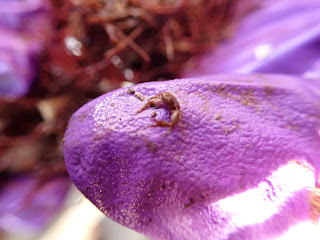The aim of the practical was to investigate how the chance of success of fertilisation of Psammechinus miliaris, the green sea urchin, changes with concentration of sperm. To do this, we had to make live specimens spawn, which involved injecting them with KCl. This part was quite risky because not only was it difficult to inject them properly, KCl can cause heart attacks in humans (if enough is injected). I didn't particularly enjoy feeling the crunch as the needle went in through the Aristotle's lantern (a complex mouth-like contraption made of calcareous material).
The needle was supposed to go through the hole in the centre of the dark ring, but as they had 'shut' their Aristotle's lanterns, we had to inject it diagonally through the dark ring you can see above.
Here's proof I was actually doing the experiment.
Below is a video of the urchin's reaction after being injected with KCl solution. It's not writhing about in pain because they don't have a complex nervous system, don't worry, and this happens to them in the wild (just not with a needle)
After 15-20 mins, the urchins released a milky white substance. Females released eggs that were visible to the naked eye, so easily identified under a microscope (one of the reasons this experiment is popular in universities running biology-related courses). Below is a photo of what they looked like after spawning:
We then collected several samples of this solution, from both males and females, and diluted the male spawn so there was a series of decreasing concentrations. The eggs from the female spawn were then added (all the same concentrations) and left for 10 minutes. After this, the percentage of fertilised eggs was counted under the microscope. What we saw was really quite amazing.
Above is a video taken with my camera down the optical lens of the microscope, zoomed in a bit so it's a bit blurry, but what you can see is sea urchin sperm.
Sea urchin eggs, magnified by 10x
Eggs, magnified by 20x
This photo really made me realise how amazing what we were doing was; what you can see is a fertilised egg. You can tell by the ring around it. Later on, we actually saw some divide. This was our first successful fertilisation- our first sea urchin babies!
You can see various stages of fertilisation here, but more notably is the egg in the middle, 2/3 up the page, that has undergone its first division.
More eggs, the bottom one is definitely fertilised, the top one is not.
A random phytoplankton cell. These microscopic algae look enormous compared to the sperm and eggs.
This is my favourite photo of the day. The egg cell on the top has just been fertilised, the one beneath it has undergone 2 divisions. You can see four cells. As cheesy as it sounds, it did hit me that we had created life, and it seemed a bit of a shame to waste it. But sea urchins are capable of releasing billions of eggs/sperm in their lifetime, so it's not massively wasteful compared to the millions of eggs/sperm that get carried away and not fertilised in the wild.
I loved this practical, it made me feel like a PROPER scientist, and I hope we get to do something like this again. After the practical, Sarah and I went to the Discovery Collection again to do more cataloguing, and we found these adorable squid:
Ok this is more terrifying than adorable, these are the suckers on a squid. They have loads of tiny, really sharp teeth on them. I think the species is a Humboldt squid, but I'm not sure. If you want to try googling it yourself, the species is either Todarodes saggitatus or Todaropsis eblanae (I can't remember)
The tiniest squid I have ever seen, I think Neorossia caroli or possibly Sepiolidae.



































































